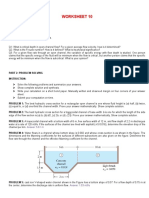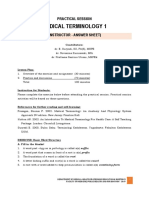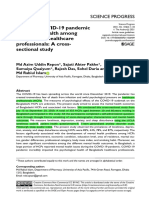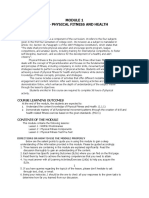ENSC3003 Asst2 S1 13
ENSC3003 Asst2 S1 13
Uploaded by
louis_parker_5553Copyright:
Available Formats
ENSC3003 Asst2 S1 13
ENSC3003 Asst2 S1 13
Uploaded by
louis_parker_5553Original Description:
Original Title
Copyright
Available Formats
Share this document
Did you find this document useful?
Is this content inappropriate?
Copyright:
Available Formats
ENSC3003 Asst2 S1 13
ENSC3003 Asst2 S1 13
Uploaded by
louis_parker_5553Copyright:
Available Formats
ENSC3003 Fluid Mechanics Assignment 2 Hydrostatics/Shell Momentum Balances Questions 3, 4 and 8 are to be submitted for marking Assignment Due
e : 4:00 pm on Monday, March 25th, 2013; The assignment must be submitted to LMS in pdf form
1.
A storage tank contains a slurry of mineral sands and water. The tank is 4.5 metres long, 4.5 metres wide, and 3.25 metres deep. The tank is filled to the brim. The tank has a roof, but it may be assumed that standard atmospheric pressure acts on the water surface. (a) (b) (c) (d) (e) (f) What is the density of the slurry, if it has a specific gravity of 1.35? If the slurry is 3 metres deep, what are the absolute and gauge pressures (in Pascals) at the bottom of the tank ? What is the pressure head (in metres of water) at the bottom of the tank? Calculate the force exerted by the water on the base of the tank. Calculate the force exerted by the water on the side of the tank. Calculate the depth of the centre of pressure on the side wall.
2.
In the two fluid manometer depicted below, the pressure of water flowing in a pipe (SG=1) is measured, with mercury (SG=13.85) used as the manometer fluid. The open end of the manometer is exposed to a vacuum (absolute pressure = 0). Determine the gauge pressure at the centre-line of the pipe for the manometer levels depicted below.
3.
An inclined wall bounding a body of water is depicted in the diagram below. The face of the wall is 6 metres long and 10 metres wide (in the direction into the page). The water body is full to the top of the wall and open to the atmosphere. Determine: (a) (b) (c) (d) The absolute and gauge pressures at the base of the wall (in Pascals) The pressure head at the base of the wall (in metres of water) The total force acting on the wall (in Newtons), and the direction that the force acts in. The position of the centre of pressure.
4.
A body of water is held back behind a 5 metre wide diamond shaped wall, as illustrated in the diagram below (the diamond is a square rotated to a 45 degree angle). The water surface is level with the top of the wall (and thus water lies only to the left of the centreline of the wall), and atmospheric pressure acts at the surface. Calculate the horizontal and vertical components of the pressure force (in Newtons) acting on the dam wall. Your answer must identify the direction in which each force component acts. You may use "shortcuts" in determining your answers, and assume that the density of water is 1000 kg/m3.
2 metres
5.
A crude canoe is made from a rectangular fibreglass box 3 feet wide, 3 feet deep, and 6 feet long. The canoe itself has a mass of 25 kilograms, and is paddled by a man weighing 90 kilograms. What is the maximum percentage of the canoe volume that can be filled with water while the canoe still floats? Assume the thickness of the canoe is negligible compared with its other dimensions. A Newtonian fluid is flowing a steady state in a vertical circular pipe 20 mm in diameter. The specific gravity of the fluid is 0.95, and the absolute viscosity of the fluid is 275 centipoise. (a) In the normal flow configuration, fluid flows downward. The head loss gradient in the direction of flow is 0.52 m (H2O)/metre. Assuming that the flow is laminar, determine the volume flow rate in the pipe. Determine the average flow velocity in the pipe, and the magnitude and location of the maximum flow velocity Determine whether the assumption of laminar flow in parts (a) and (b) is justified It is sought to triple the flow rate in the pipe by changing the pipe diameter. If the pressure gradient, viscosity and specific gravity are unchanged, determine the pipe diameter required to achieve this. An error in construction results in the pipe being oriented such that the fluid actually flows upward. How would you correct the Hagen-Poiseuille equation to calculate the flow rate for this situation ?
6.
(b) (c) (d)
(e)
7.
Two immiscible fluids are flowing in laminar pressure-driven flow between two parallel plates. Is it possible that the velocity profiles would be of the form depicted below? Explain your answer.
A Newtonian fluid is in pressure driven laminar flow in a horizontal narrow slit formed by two parallel walls separated by a distance 2B, as illustrated below. The pressure at the entry to the section is PO, the pressure at the exit is PL. It may be assumed that 2B<<W (W is the width in the direction into the page), so that edge effects are unimportant. Gravity acts straight down, and the system is at steady state. Using the axes shown on the figure below, set up a differential momentum balance, and obtain expressions for (a) The shear stress (as a function of y). (b) The velocity distribution (as a function of y). (c) The volume flow rate. (d) Explain (using a meaningful sketch) why these equations would not be valid if B=W
9.
In a gas absorption experiment, a viscous film flows (in laminar flow) down the outside of a small circular tube at steady state, as illustrated below. Set up a momentum balance over a shell of thickness r in the film, and derive: (a) The expression for the velocity distribution in the film (as a function of radius) (b) An expression for the mass flow rate in the film. You may assume that the film thickness is constant in the axial (z) direction, that end effects may be neglected (ie consider a shell of fixed length L), and that gravity acts in the negative Z direction. The dashed line represents the centreline of the cylinder.
You might also like
- Homeworks 1-10 PDFDocument95 pagesHomeworks 1-10 PDFWendy LinNo ratings yet
- FM Dec - 2009Document20 pagesFM Dec - 2009Divyesh Morabiya80% (5)
- UBC CHBE 251 - Fluid Mechanics - Problems From Past FinalsDocument14 pagesUBC CHBE 251 - Fluid Mechanics - Problems From Past FinalsflybossladiNo ratings yet
- IMPORTANT QUESTIONS For Final (KEC) Fluid Mechanic - Line Academy Part 1Document45 pagesIMPORTANT QUESTIONS For Final (KEC) Fluid Mechanic - Line Academy Part 1आदित्य राज अधिकारीNo ratings yet
- Group Assignment IDocument5 pagesGroup Assignment Ilelisagetachew90No ratings yet
- AnnieDocument6 pagesAnnieAnnie Glorina LumauigNo ratings yet
- Tutorial Ch1 ProblemDocument5 pagesTutorial Ch1 ProblemKiat HauNo ratings yet
- Assignment 2 - CE2040Document4 pagesAssignment 2 - CE2040Ash0% (1)
- Fluid Mechanics July 2013Document0 pagesFluid Mechanics July 2013Prasad C MNo ratings yet
- FM Test 1Document10 pagesFM Test 1ReginaldRemoNo ratings yet
- Group Assignment II - FinalDocument7 pagesGroup Assignment II - Finallelisagetachew90No ratings yet
- MEC222 - 5 Fluid Mechanics QP - Amrita UniversityDocument4 pagesMEC222 - 5 Fluid Mechanics QP - Amrita UniversityAkshay RajanNo ratings yet
- Practice Problems Set 3Document5 pagesPractice Problems Set 3Shashwat Singh JamwalNo ratings yet
- Homework SolutionDocument25 pagesHomework SolutionHirman De Nova0% (1)
- MM204 Assn3 2017Document5 pagesMM204 Assn3 2017jayNo ratings yet
- FMMQP 01Document2 pagesFMMQP 01tvkbhanuprakashNo ratings yet
- Workbook FMDocument66 pagesWorkbook FMSubhash JhurawatNo ratings yet
- Fluid Mechanics Assignment-5 (Momentum Conservation) : Aditya BandopadhyayDocument9 pagesFluid Mechanics Assignment-5 (Momentum Conservation) : Aditya BandopadhyayGunda Venkata SaiNo ratings yet
- Problem Questions For Potential FlowsDocument3 pagesProblem Questions For Potential FlowsSnehal SinhaNo ratings yet
- Q 1Document4 pagesQ 1Manu K VasudevanNo ratings yet
- Supplement Questions of FLUID MECHANICS: Paragraph For Question Nos. 1 To 3Document7 pagesSupplement Questions of FLUID MECHANICS: Paragraph For Question Nos. 1 To 3Tanuj Gupta0% (2)
- Assignment I SKPU1123 1213 2Document4 pagesAssignment I SKPU1123 1213 2Rajab AliNo ratings yet
- Problem A RioDocument9 pagesProblem A RioKoe Chien ThongNo ratings yet
- Assignment Fluid MechanicsDocument9 pagesAssignment Fluid MechanicsAmirul AshrafNo ratings yet
- FluidsDocument8 pagesFluidsAnonymous 9kzuGaYNo ratings yet
- Fluids-Chapter 3-Tutorial-1Document11 pagesFluids-Chapter 3-Tutorial-1phizygNo ratings yet
- Flow of Water Through SoilsDocument11 pagesFlow of Water Through SoilsRajesh KhadkaNo ratings yet
- FMDocument13 pagesFMSaurabh TiwariNo ratings yet
- Eng Trial ExamDocument11 pagesEng Trial ExamudinjcNo ratings yet
- Tutorial PE104Document7 pagesTutorial PE104aquabeefmanNo ratings yet
- Scribd Download - Com Fluid Mechanics Lecture 2 Problems and AnswersDocument6 pagesScribd Download - Com Fluid Mechanics Lecture 2 Problems and AnswersRomil ShahNo ratings yet
- FLUID I CH 5 Fluid Dynamics Analysis Control Volume Tut 5Document9 pagesFLUID I CH 5 Fluid Dynamics Analysis Control Volume Tut 5Naser KhalidNo ratings yet
- Topic-Wise GATE1Document32 pagesTopic-Wise GATE1CHHAVI AGARWAL0% (1)
- Problem Set #2 WPS 760Document15 pagesProblem Set #2 WPS 760weilong9183% (12)
- CP S HW CH 9 DetailedDocument6 pagesCP S HW CH 9 DetailedVei AdoptanteNo ratings yet
- Fluid Mechanics ProblemsDocument3 pagesFluid Mechanics ProblemsTaker BloodNo ratings yet
- (777577664) Numerical Problem 3Document5 pages(777577664) Numerical Problem 3Axel0% (1)
- FM GateDocument50 pagesFM GateIndhira Devi PNo ratings yet
- ENGR207 - Assignment#1Document4 pagesENGR207 - Assignment#1Mohamed KhairyNo ratings yet
- OpDocument88 pagesOpMahmud Rahman BizoyNo ratings yet
- Assignment 5-2Document2 pagesAssignment 5-2DeZ MNo ratings yet
- Practice Problem Set - IIIa PDFDocument7 pagesPractice Problem Set - IIIa PDFMukul ChandraNo ratings yet
- 流體力學Document30 pages流體力學sonkuas100% (1)
- 2022 ZEIT2500 Fluids AssignmentDocument4 pages2022 ZEIT2500 Fluids AssignmentViral ThakkarNo ratings yet
- Tutorial Sheet 6Document2 pagesTutorial Sheet 6LabibaNo ratings yet
- Answer Any Two QuestionsDocument11 pagesAnswer Any Two QuestionsKirtismita TalukdarNo ratings yet
- Worksheet 10: AnswerDocument2 pagesWorksheet 10: AnswerMac KYNo ratings yet
- Fluid Mechanics Lecture 2 Problems and AnswersDocument5 pagesFluid Mechanics Lecture 2 Problems and AnswersAlex LakeNo ratings yet
- CC Students Meng 2 SimulDocument3 pagesCC Students Meng 2 Simulvanou5353No ratings yet
- Chapter 7 ProblemsDocument3 pagesChapter 7 ProblemsLương Thị Quỳnh PhượngNo ratings yet
- September 24, 2015: Krill, N'rimbetDocument2 pagesSeptember 24, 2015: Krill, N'rimbetVinay DograNo ratings yet
- Wren201 Tutorial Questions-2Document12 pagesWren201 Tutorial Questions-2yemivibezNo ratings yet
- DPP - Solids & FluidsDocument6 pagesDPP - Solids & FluidsMohammed Aftab AhmedNo ratings yet
- CPP FiitjeeDocument18 pagesCPP FiitjeeAmey Kale0% (1)
- Fluid Statics ExerciseDocument5 pagesFluid Statics ExercisechitooNo ratings yet
- Compiled Question Ce 3227Document9 pagesCompiled Question Ce 3227Hamisi MzariNo ratings yet
- Engineering Mechanics TutorialDocument3 pagesEngineering Mechanics TutorialMrunmayi AthavaleNo ratings yet
- The Mechanics of Water-Wheels - A Guide to the Physics at Work in Water-Wheels with a Horizontal AxisFrom EverandThe Mechanics of Water-Wheels - A Guide to the Physics at Work in Water-Wheels with a Horizontal AxisNo ratings yet
- ASYNCHRONOUS ACTIVITY - Common AbbreviationsDocument3 pagesASYNCHRONOUS ACTIVITY - Common AbbreviationsRed DinsonNo ratings yet
- 1 - Kunci Jawaban PS Medical Terminology 1 vg2ZY JQZDocument7 pages1 - Kunci Jawaban PS Medical Terminology 1 vg2ZY JQZrhn 5b1coolNo ratings yet
- 3 ConvectionDocument44 pages3 ConvectionromasokyNo ratings yet
- One Dimensional ConsolidationDocument2 pagesOne Dimensional ConsolidationPaschal MazikuNo ratings yet
- Questionnaire Qualitative ResearchDocument1 pageQuestionnaire Qualitative ResearchAlvin MontesNo ratings yet
- MyselfDocument5 pagesMyselfSABA ALINo ratings yet
- CGTX Cognition TherapeuticsDocument8 pagesCGTX Cognition TherapeuticsZluNo ratings yet
- F-4 (BD 1) Mental Health-HCPsDocument18 pagesF-4 (BD 1) Mental Health-HCPstowhidul alamNo ratings yet
- Main Report - 40 MT TankerDocument16 pagesMain Report - 40 MT TankertexcreaterNo ratings yet
- 70-698 BraindumpsDocument13 pages70-698 BraindumpsMichealNo ratings yet
- Chicken BiryaniDocument2 pagesChicken Biryanihivadon199No ratings yet
- Bloodborne Lore - Father GascoigneDocument3 pagesBloodborne Lore - Father GascoigneshaunNo ratings yet
- Instruction Manual 6.5L Slow Cooker: EnglishDocument15 pagesInstruction Manual 6.5L Slow Cooker: EnglishJurgen En Mari BeckenbauerNo ratings yet
- WR Led Specs 2016Document10 pagesWR Led Specs 2016Sr. DEENo ratings yet
- Ultrasonography of The Neck: O. Taeymans, DVM, Dip ECVDIDocument73 pagesUltrasonography of The Neck: O. Taeymans, DVM, Dip ECVDIKSNo ratings yet
- Handbook of Thermal&NuclearEngineeringDocument402 pagesHandbook of Thermal&NuclearEngineeringNino V. Nieves100% (2)
- Pe 1 - Physical Fitness and Health: Physical Education Is A Component of The Curriculum. It Refers To The Four SubjectsDocument24 pagesPe 1 - Physical Fitness and Health: Physical Education Is A Component of The Curriculum. It Refers To The Four Subjectscristymarrie mellaNo ratings yet
- Soal Jawab Siap UTS PTS II Bahasa InggriDocument6 pagesSoal Jawab Siap UTS PTS II Bahasa InggriAskme AzmyNo ratings yet
- EE-SV3 Series: Photomicrosensor (Transmissive)Document2 pagesEE-SV3 Series: Photomicrosensor (Transmissive)hüseyin vururNo ratings yet
- Classes of CompoundsDocument12 pagesClasses of CompoundsReynaldo VirtucioNo ratings yet
- Photosynthesis - Definition & ReactionsDocument8 pagesPhotosynthesis - Definition & ReactionsTameka GrayNo ratings yet
- Testing & Commissioning of Domestic Water PumpsDocument5 pagesTesting & Commissioning of Domestic Water PumpsHishamGharbiahNo ratings yet
- 2023 Ohio State Fair Media GuideDocument65 pages2023 Ohio State Fair Media GuideMatt ThomasNo ratings yet
- AP Pop Quiz 2024Document3 pagesAP Pop Quiz 2024mia00117650% (2)
- Manpower For Plumbing and Fire FightingDocument10 pagesManpower For Plumbing and Fire FightingSharad SawantNo ratings yet
- 00 Reading ListDocument2 pages00 Reading ListEleanor ChanNo ratings yet
- Faiz Ilham Mumtaz Social 2Document2 pagesFaiz Ilham Mumtaz Social 2Kuro DitNo ratings yet
- Sole Cataleg enDocument112 pagesSole Cataleg enYa HooNo ratings yet
- Fuchs Reniso KC 68 SdsDocument6 pagesFuchs Reniso KC 68 Sdsbazoka fransiskusNo ratings yet
- Dual-Synchronous, Step-Down Controller With Out-Of-Audio™ Operation and 100-Ma Ldos For Notebook System PowerDocument40 pagesDual-Synchronous, Step-Down Controller With Out-Of-Audio™ Operation and 100-Ma Ldos For Notebook System PowernelsonNo ratings yet

























































































